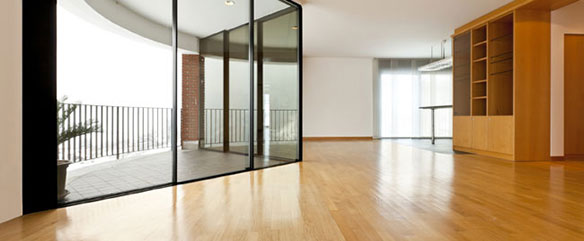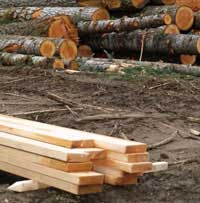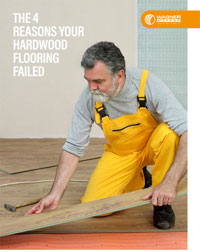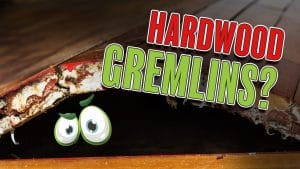5 Preventable Hardwood Flooring Problems
When looking for warm and natural flooring, wood tops the list. The range of colors, grains and varieties make it possible to achieve a durable look that harmonizes with any décor or lifestyle.

However, part of what makes wood so appealing, its natural structure and abundant supply, is also what makes it open to some common problems. These problems are all connected to the relationship between wood and moisture.
Hygroscopic: What That Means for Your Floor
Wood is a hygroscopic material, which simply means it easily absorbs moisture.
Wood cells fit together like groups of drinking straws or thin pipes. The cell wall naturally contains a small amount of moisture, and the “hollow” part of the cell also has room to hold and release moisture. While a tree is growing, this cell interior conducts water and nutrients from the roots to the various parts of the tree.

Once a tree has been cut, the “green” lumber is kiln-dried to remove the bulk of that mobile moisture before the lumber is manufactured into various wood products. The structure of the cell remains the same, with room to reabsorb and release moisture from its surroundings. That moisture may come from an external source (like groundwater or leaking plumbing) or water in the atmosphere (relative humidity), but it is crucial to note that there is a continuous interaction between wood and its environment.
The catch, for any woodworker or wood flooring expert, is that as this process takes place, the dimensions of the wood will expand or contract depending on how the wood is absorbing or releasing moisture based on the environment around it. When the rate of expansion or contraction changes too drastically, wood flooring will show some tell-tale, and potentially problematic, signs.
5 Moisture-Related Flooring Problems
Cupping
Wood floor cupping is caused by a moisture imbalance through the thickness of the wood, and shows up as a curve from side to side; the edges are higher than the center. It may be a water source from below the flooring, or from ambient relative humidity (RH) changes in the surrounding environment that caused the boards to expand further than the space given them during installation. The resulting pressure would force the board edges upwards, creating a washboard effect.
Crowning
Crowning is also a result of moisture imbalance, but is the inverse of cupping; the center is higher than the edges. It may result from excess moisture on the face (top) of the flooring, but it may also happen if a cupped floor was sanded and finished before properly reaching a moisture balance with its environment. As moisture leaves the boards, the edges that were sanded down shrink even further, leaving the centers raised.
Abnormal Gaps
Some slight spaces between boards are common and are only a seasonal variation as ambient RH changes. However, if the flooring was installed while the moisture content (MC) was still higher than the ambient conditions, the spaces between the boards will grow larger as the boards dry. The wider the board, the wider the gap will become. Large gaps can also be caused by environmental issues such as “hot spots” created by appliances or inadequately insulated heating/cooling ducts that increase the rate of moisture movement in select spots of the floor.
Buckling
Buckling in hardwood floors is really an extreme case of crowning, where extreme moisture changes actually curve the flooring to the extent that it no longer contacts the subfloor. This usually happens most often after a floor has been flooded for a period of time. Incorrect installation may contribute, too, but buckling is extreme enough to generally require correction for the moisture problem and then reinstallation.
Squeaking
When a wood floor has been subjected to repeated significant moisture changes, it can result in popped nails, subfloor problems or adhesive breakdown that means the flooring has room to move or rub against the different parts of the floor system. Those squeaks, groans, and other noises may be indicative of ongoing moisture-related problems.

Free Download – 4 Reasons Your Hardwood Flooring Failed
Minimize Problems with Moisture Measurement
The best single step that you can take to protect a wood floor from these moisture-related problems is to measure both the subfloor and the finished wood flooring’s MC thoroughly and accurately before and during installation, to instruct clients on basic maintenance during the life of the floor, and to educate the client on the natural seasonal changes of a wood floor. Read our hickory hardwood flooring pros and cons to learn more about this specific type of flooring.
A wood moisture meter can be used to measure and assess the MC of a wood flooring at any stage, from delivery to the job site, through every step of installation, to routine maintenance during use. By understanding the relationship between wood flooring and MC, accurately determining when the floor has reached an equilibrium with its surroundings can let installers minimize the potential problems of excess moisture in the finished floor.
An accurate wood moisture meter represents the ounce of proverbial prevention for a pound of possible problems for any wood floor.
Larry Loffer is a senior technician at Wagner Meters, where he has over 30 years of experience in wood moisture measurement. With a degree in Computer Systems, Larry is involved in both hardware and software development of wood moisture measurement solutions.
Related Posts via Taxonomies
Last updated on August 18th, 2022





Hi Larry,
I have a major problem with the oak flooring on the second story of my home. In the early 90’s we had the carpet replaced with professionally installed oak hardwood. Beautiful finished. Never had any issue with it. About one month ago I noticed some cupping in my closet along the back outside wall.
Now it is cupping across the whole back wall. No water or moisture has ever been it that area.
The wood directly adjacent to the master bathroom are not cupping. Not in the closet area with access to the tub plumbing or at the door to the bathroom.
That leads me to believe it is not coming from a bathroom leak.
Please please give me direction.
Regina McPherson
Hi Regina,
When cupping occurs and the edges of the flooring are curling upwards, that is an indication of moisture below the flooring. It could also mean there is high humidity below, or, very low humidity on the second floor. If it is happening near an outside wall, perhaps water is coming in from outside. If possible, remove a section of flooring and check the subfloor with a moisture meter. Typical plywood or OSB subfloor material should be about 12% moisture content.
Oak floor laid through house somevboards seem buckled at edges can I help thanks
Hi Anne,
A buckled floor is a good indication that water is, or was, present under the floor or in the subfloor before the flooring was installed. Moisture can also damage a floor from an appliance leak. A Wagner moisture meter will help identify the location of the leak. Click on this link for more information: https://www.wagnermeters.com/moisture-meters/
If the damage is minimal, there’s a good chance of saving the floor. Please visit https://www.nwfa.org/ for help.
Very interesting article. Thank you very much for sharing,
installed a floor new home wood 5 inches wide solid wood was 6 percent subfloor 8 percent installed in feb but large gaps appeared and didnt seem to go back in humid summer.What do you think
Michael,
Six percent wood flooring is very dry. If anything, it should have swelled a little and expanded. Was a moisture meter used to check every piece? Was this flooring acclimated to the room at least 2 weeks before installing?